Students get through AP Inter 1st Year Physics Important Questions 7th Lesson Systems of Particles and Rotational Motion which are most likely to be asked in the exam.
AP Inter 1st Year Physics Important Questions 7th Lesson Systems of Particles and Rotational Motion
Very Short Answer Questions
Question 1.
Is it necessary that a mass should be present at the centre of mass of any system? [TS 22; IPE’ 14; AP 16]
Answer:
No. It is not necessary for mass to be there at the centre of Mass.
Ex: Ring has centre of mass at its centre, where there is no mass.
Question 2.
What is the difference in the position of a girl carrying a hag in one of her hands and another girl carrying a bag in each of her two hands?
Answer:
In the case of a girl carrying a bag in one of her hands, the centre of mass of her body will be shifted towards the hand in which she is carrying the bag.
In the case of a girl carrying a bag in each of her two hands (mass of each bag same) there will be no change in the position of her centre of mass.
Question 3.
Two rigid bodies have same moment of inertia about their axes of symmetry. Of the two, which body will have greater kinetic energy? [Imp.Q]
Answer:
K.ER = \(\frac{1}{2}\) Iω².
For the same moment of Inertia K.ER or ω²
Question 4.
Why are spokes provided in a bicycle wheel? [Imp.Q; IPE’ 13, 14]
Answer:
The spokes of cycle wheel increase its moment of inertia. The greater the moment of inertia, the greater is the opposition to any change in uniform rotational motion. As a result, the cycle runs smoother and steadier. If the cycle wheels had no spokes, the cycle would be driven in jerks and hence unsafe.
Question 5.
We cannot open or close the door by applying force at hinges. Why? [AP 16; TS 22]
Answer:
Torque = force × lever arm of the force
When the force is applied at hinges, lever arm of the force will be zero. So there will be no torque and hence we cannot open or close the door.
![]()
Question 6.
Why do we prefer a spanner of longer arm as compared to the spanner of shorter arm?
Answer:
Torque = force × lever ami of the force
When we use a spanner of longer arm, lever ami of the force will be large. So the torque produced will also be more. So the body can be rotated easily. Hence we prefer a spanner of longer arm to spanner of shorter ami.
Question 7.
By spinning eggs on a table top, how will you distinguish a hard boiled egg from a raw egg? [Imp.Q; TS 22]
Answer:
A boiled egg is nearly a rigid body and has low moment of inertia. Hence for the same torque boiled egg spins faster. In case of a raw egg, the liquid matter would tend to move away from the rotational axis under the influence of centrifugal force. This would increase the moment of inertia and consequently, the angular velocity gets decreased.
Question 8.
Why Should a helicopter necessarily have two propellers? [Imp.Q]
Answer:
If there were only one propeller, then according to law of conservation of angular momentum, the helicopter would rotate itself in the opposite direction. So a helicopter necessarily have two propellers.
Question 9.
If the polar ice caps of the earth were to melt, what would the effect of the length of the day be?
Answer:
If the polar ice melts, the water formed will spread over the surface of the earth. As a result, the moment of inertia of earth will increase. Since angular momentum (=1ω) of earth remains constant, co will decrease. This means the earth will complete one revolution about its own axis in a longer time instead of 24 hours. Hence the length of the day will increase.
Question 10.
Why is it easier to balance a bicycle in motion? [Imp.Q]
Answer:
The rotating wheels of a bicycle possess angular momentum. In the absence of an external torque, neither the magnitude nor the direction of angular momentum change. The direction of angular momentum is along the axis of the wheel. So the bicycle does not get titled.
Short Answer Questions
Question 1.
Distinguish between centre of mass and centre of gravity. [AP,TS 15, 16, 17, 18, 22]
Answer:
| Centre of mass | Centre of gravity |
| 1) This is the point at which entire mass of the body is supposed to be concentrated. | 1) This is the point at which the weight of the body acts. |
| 2) Centre of mass is independent of acceleration due to gravity. | 2) Centre of gravity depends upon acceleration due to gravity. |
| 3) It may (or) may not lie inside the body. | 3) It always lie inside the body. |
| 4) This concept is useful while dealing with motion of body | 4) This concept is useful while dealing with stability of body. |
![]()
Question 2.
Show that a system of particles moving under the influence of an external force, moves as if the force is applied at its centre of mass. [AP 18]
Answer:
If ‘n’ particles of masses m1, m2 ………… mn are moving with accelerations a1, a2 ………. an then the acceleration of center of mass is given by
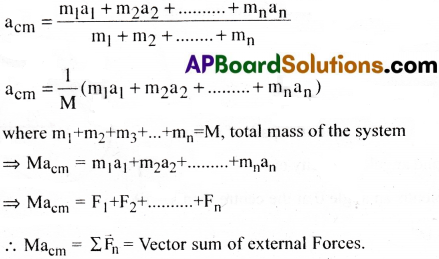
Hence, Macm = Fext where Fcxt represents the sum of all external forces acting on the particle of the system. The above equation shows that the centre of mass of a system of particles moves as if all the mass of the system was concentrated at the centre of mass and all the external forces were applied at that point.
Question 3.
Explain about the centre of mass of Earth-moon system and its rotation around the sun.
Answer:
The earth-moon system rotates about the common centre of mass. The mass of the earth is about 81 times that of the moon.
The distance between the centres of the earth and the moon is 3.81 × 105 km. The centre of mass of the earth-moon system locate relatively very nearer to the centre of the earth. The interaction of the earth and moon does not affect the motion of the centre of mass of the earth-moon system. The gravitational attraction of the sun is the only external force that acts on the earth-moon system and the centre of mass of the earth-moon system moves in an elliptical path around the sun.
Question 4.
Define vector product. Explain the properties of a vector product with two examples. [AP, TS 15, 16, 17, 18, 19; AP 20,22]
Answer:

Question 5.
Define angular velocity(ω). Derive v = rω. [TS 19, 22; IPE’ 14; AP 16, 17]
Answer:
Angular velocity(ω):
The rate of change of angular displacement is called angular velocity (ω). If a particle undergoes an angular displacement dθ in the time interval dt,
then its angular velocity, ω = \(\frac{d\theta}{dt}\)

Derivation of the relation v = rω
Let us consider a particle moving along a circular path of radius
r with linear velocity v and and angular velocity to ω.
The arc p1p2 of length s subtends an angle θ at the centre then s = rθ
Differentiating w.r.to ‘f, we get

Question 6.
Define angular acceleration ami torque. Establish the relation between angular acceleration and torque. [AP 19, 19; TS 18, 20; AP, TS 15]
Answer:
Angular acceleration :
Rate of change of angular velocity is called angular acceleration. If the angular velocity of a body changes by dω in time dt, then its angular acceleration
α = \(\frac{d\omega}{dt}\)
Torque :
The turning effect or moment of force about an axis of rotation is called the torque. If a force \(\overline{\mathrm{F}}\) is applied on a particle whose position vector is \(\overline{\mathrm{r}}\) w.r.to origin, then torque
\(\bar{\tau}=\overline{\mathrm{r}} \times \overline{\mathrm{F}}\)
Relation between torque(τ) and angular acceleration(α):
Let us consider a rigid body of moment of inertia I rotating about a fixed axis AB through its centre of mass, O as shown in the figure, under the effect of an external torque.
Let m1, m2, m3 …. = masses of various particles constituting the body.
r1, r2, r3 …… = perpendicular distances of these particles from the axis of rotation.
a1, a2, a3, …….. = linear accelerations of these particles
α = uniform angular acceleration of the body about the given axis of rotation.
(α is same for all the particles of the body)

We know that a1= r1α, a2 = r2α, a3 = r3α…….
Force acting on particle of mass m1 = m1a1 = m1a1α
Torque acting on particle of mass m1 about the given axis of rotation = m1r1α(r1) = m1r1²α
Similarly, torques acting on particles of masses
m2, m3, ……… are m2r2²α, m3r3²α, ………..
Sum of all the torques about the fixed axis is
τ = (m1r1² + m2r2² + m3r3² +….)α
τ = (∑mr2 )α . Here, ∑ = mr² =I, moment of inertia of the body.
⇒ τ = Iα
![]()
Question 7.
Write the equations of motion for a particle rotating about a fixed axis. [AP 19]
Answer:
When a body is rotating with constant angular acceleration (a), the rotational kinematical equations are
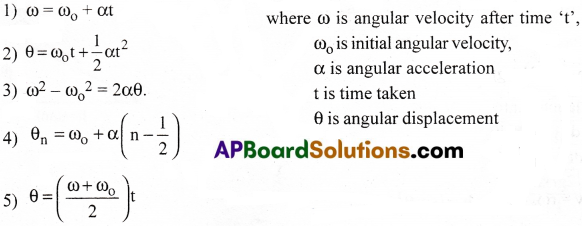
Question 8.
Derive expressions for final velocity and total energy of a body rolling without slipping.
Answer:
Rolling motion can be treated as the combination of translatory and rotational motion. Therefore K.E of rolling body is the sum of K.E of translation and K.E of rotation.
K.E of rolling body = K.ET + K.ER
But translational K.E of rolling body K.ET = \(\frac{1}{2}\)mv²cm
Where M= Mass of the body, vcm = Velocity of centre of mass
K.E of rotation of the rolling body K.ER = \(\frac{1}{2}\) Iω²
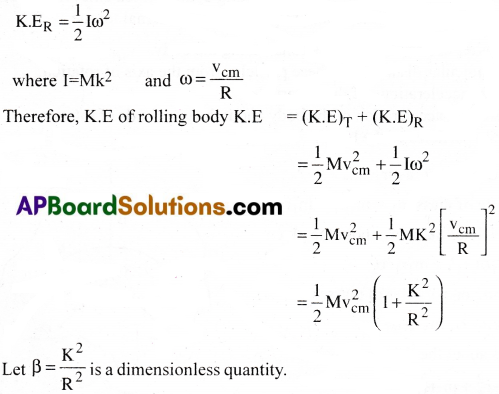
It varies from body to body and axis to axis
∴ Total kinetic energy of a rolling body K.ETotal = \(\frac{1}{2}\)Mv²cm (1 + β)
Final velocity of rolling body without slipping :
Let the final velocity of rolling body on reaching to the bottom of the inclined plane is v. Then according to Law of conservation of energy (RE) = (K.E)

Long Answer Questions
Question 1.
(a) State and prove parallel axes theorem. [lmp.Q]
(b) For a thin flat circular disk, the radius of gyration about a diameter as axis is K. If the disk is cut along a diameter AB as shown in to two equal places, then find the radius of gyration of each piece about AB.

Answer:
Parallel axes theorem The moment ofinertia(I) of a rigid body about an axis passing through a point is equal to the sum of
a) Its moment of inertia about a parallel axis passing through its centre of mass IG
b) The product of mass of the body and square of the perpendicular distance between the axes
(Mx²). Thus I = IG + Mx²
Proof :
Consider a plane lamina of mass ‘M’ having its centre of mass at ‘G’. Consider an axis AB passing through the point ‘O’ about which the moment of inertia of the body is to be found. Consider a particle of mass ‘nr at a distance r from the axis AB. Consider another axis CD passing through G and parallel to AB, so that the distance between the two parallel axes is ‘x’. Moment of Inertia of a body about the axis AB is I = ∑mr² —— (1)
Moment of Inertia of the lamina about the axis passing through the center of mass ‘G’ is IG
IG = ∑mb² —— (2)
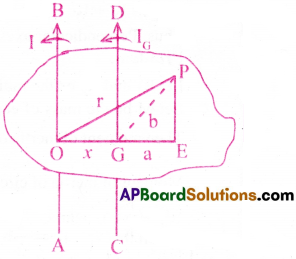
From ∆ OPE , OP² = OE² + EP² = (OG + GE)² + EP²
= OG² + GE² + 2.OG.GE + EP²
But from ∆ GPE, GE² + EP² = GP²
∴ OP² =OG² +GP² +2.0G.GE
⇒ r² = x² + b² + 2.xa
Now, I = X m r² = X m (x² + b² + 2xa)
I = ∑ mx² + ∑ mb² + ∑m(2xa) = Mx² + IG+ 2∑m(xa)
But, algebraic sum of the moments about centre of mass (∑mx).a = 0
∴ I = IG + Mx²
Problem :
Let M be the mass of flat circular disc andR be its radius. Then moment of inertia of circular disc about diameter AB is I = \(\frac{1}{2}\) MR² ………… (1)
If K is radius of gyration of circular disc, then its moment of inertia is I = MK² ………… (2)
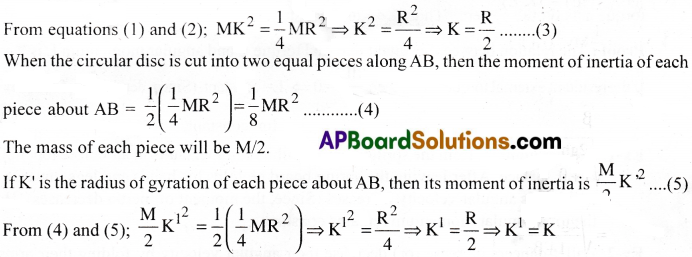
Hence radius of gyration of each piece about AB is K.
![]()
Question 2.
(a) State and prove perpendicular axes theorem [Imp.Q]
(b) If a thin circular ring and a thin flat circular disk of same mass have same moment of inertia about their respective diameters as axes, then find the ratio of their radii.
Answer:
Perpendicular axes theoren :
‘The moment of inertia of a Rigid body’ about ‘an axis perpendicular to its plane and passing through a certain point’, is equal to ‘the sum of its moments of inertia about any two axes’ in that plane ,which are mutually perpendicular and passing through that point.
Thus IZ = IX + IY
Proof Consider a plane lamina of mass ‘M’.
It is divided into no.of small particles, each of mass ‘m’.
Let a particle P of mass ‘m’ with coordinates (x, y) be at a distance r from the axis OZ.
Moment of inertia of the plane lamina about the Z-axis is IZ = ∑mr²
Moment of inertia of the plane lamina about the X-axis is, IX = ∑my²
Moment of inertia of the plane lamina about the Y-axis is, IY = ∑mx²

But r² = x² + y²
∴ IZ = ∑mr² = ∑m(x² +y²) = ∑mx² + ∑my²
⇒ IZ = IX + IY
Thus, Perpendicular axes theorem is proved.
Problem:
Let R1 and R2 be the radii of circular ring and circular disc respectively.
Let M be the mass of each one.

Question 3.
State and prove the principle of conservation of angular momentum. [AP 16]
Explain the principle of conservation of angular momentum with examples.
Answer:
Statement :
The angular momentum of a system always remains constant, when no external torque acts on the system. Thus, L = I ω = constant
Proof :
The relation between resultant external torque τ and angular momentum L is τ = \(\frac{dL}{dt}\). If the resultant external torque τ = 0,then \(\frac{dL}{dt}\) = 0 ⇒ L = constant. (Since, derivative of constant is 0).
Iω = constant; I ∝ \(\frac{1}{\omega}\)
Ex-1:
A diver jumping from the spring board exhibits summersaults in air before touching the water surface. After leaving the spring board he folds his hands and legs inwards. Due to this, his angular velocity increases (Since, the moment of inertia decreases). Hence, the total angular momentum remains constant.
Ex-2:
Pallet dancers increase (or) decrease their angular velocity by folding their arms and sketching legs close to their bodies.Thus, the total angular momentum remains constant.
Solved Problems
Question 1.
Find the centre of mass of three particles at the vertices of an equilateral triangle. The masses of the particles are 100g, 150g and 200g respectively. Each side of the equilateral triangle is 0.5m long. [AP 18; TS 15, 18]
Solution:
With the x-and y-axes chosen as shown in the figure, the coordinates of points O, A and B forming the equilateral triangle are respectively (0,0), (0.5,0), (0.25, 0.25 √3 ). Let the masses 100g, 150g and 200g be located at O, A and B be respectively.
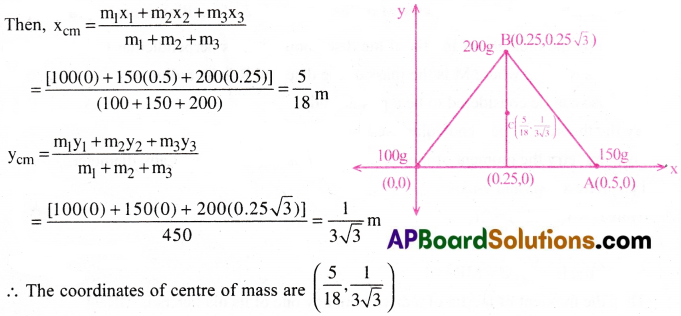
Question 2.
Find the centre of mass of a triangular lamina.
Solution:
The lamina (∆LMN) may be subdivided into narrow strips each parallel to the base (MN).

By symmetry, each strip has its centre of mass at its midpoint. If we join the midpoint of all the strips we get the median LP.
The center of mass of the triangle as a whole therefore, has to lie on the median LP. Similarly, we can argue that it lies on the median MQ and NR. This means the centre of mass lies on the point of concurrence of the medians, i.e., on the centroid G of the triangle.
Question 3.
Find the scalar and vector product of two vector, \(\overline{\mathrm{a}}=(3\overline{\mathrm{i}}-4\overline{\mathrm{j}}+5\overline{\mathrm{k}})\) and \(\overline{\mathrm{b}}=(-2\overline{\mathrm{i}}+\overline{\mathrm{j}}-3\overline{\mathrm{k}})\) [TS 20]
Solution:

Question 4.
Find the torque of a force \(7\overline{\mathrm{i}}+3\overline{\mathrm{j}}-5\overline{\mathrm{k}}\) about the origin. The force acts on a particle whose position vector is \(\overline{\mathrm{i}}-\overline{\mathrm{j}}+\overline{\mathrm{k}}\) [Imp.Q; IPE’ 13, 13, 14; TS 19]
Solution:

Question 5.
What is the moment of inertia of a disc about one of its diameters? [Imp.Q]
Solution:
We know the moment of inertia of the disc about an axis perpendicular to it and through its centre is MR²/2, where M is the mass of the disc and R is its radius.
The disc can be considered to be a planar body.
By the theorem of perpendicular axes Iz = Ix + Iy
By symmetry, the moment of inertia of the disc is the same about any diameter.
i.e., along x-axis and y-axis.
Thus Ix = Iy and Iz = 2Ix
But Iz = MR²/2
So finally, Ix = Iz/ 2 = MR²/ 4
Thus the moment of inertia of a disc about any one of its diameters is MR²/4.
![]()
Question 6.
What is the moment of inertia of a rod of mass M, length I about an axis perpendicular to it and passing through one end? [TS 19]
Solution:
For the rod of mass M and length /, the M.l of the rod about an axis passing through its centre of mass and perpendicular its plane is I = Ml²/12.
Using the parallel axes theorem, I’ = I + Ma².
With a = l/2 we get, I’ = M\(\frac{l^2}{12}+M(\frac{l}{2})^2=\frac{Ml^2}{3}\)
Question 7.
What is the moment of inertia of a ring about a tangent to the circle of the ring?
Solution:
The tangent to the ring in the plane of the ring is parallel to one of the diameters of the ring. The distance between these two parallel axes is R, the radius of the ring.
Using the parallel axes theorem.
![]()
Exercise Problems
Question 1.
Show that \(\overline{\mathrm{a}}.(\overline{\mathrm{b}}\times\overline{\mathrm{c}})\) is equal in magnitude to the volume of the parallelopiped formed on the three vectors \(\overline{\mathrm{a}},\overline{\mathrm{b}},\overline{\mathrm{c}}\).
Solution:
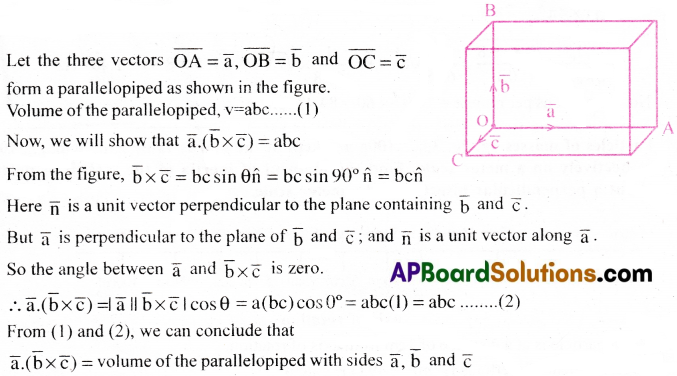
Question 2.
A rope of negligible mass is wound round a hollow cylinder of mass 3kg and radius 40cm. VVhat is the angular acceleration of the cylinder if the rope is pulled with a force of 30N? VVhat is the linear acceleration of the rope? Assume that there is no slipping.
Solution:
Mass of the hollow cylinder, M = 3kg
Radius of the hollow cylinder, R = 40 cm = \(\frac{40}{100}\) = 0.4 m
Force applied on the cylinder, F = 30N
Moment of inertia of hollow cylinder, I = MR² = 3 × (0.4) = 3 × 0.16 = 0.48 kgm²
Torque acting on the cylinder, τ = Fr = 30 × 0.4 = 12 Nm
If α is the angular acceleration produced in the cylinder, then from τ = Iα,
α = \(\frac{\tau}{\mathrm{I}}=\frac{12}{0.48}=\frac{1200}{48}\) = 25 rad /sec².
If a is the linear acceleration of the rope, then a = rα ⇒ a = 0.4 × 25 = 10ms-2.
Question 3.
A coin is kept a distance of 10cm from the centre of a circular turn table. If the coefficient of static friction between the table and the coin is 0.8, find the frequency of rotation of the disc at which the coin will just begin to slip.
Solution:
The frictional force between coin and turn table provides the necessary centripetal force. The coin will not slip as long as the centripetal force is less than or equal to maximum static friction force i.e., centripetal force ≤ fms
∴ The coin will slip when centripetal force = fms
⇒ mrw² = µsmg
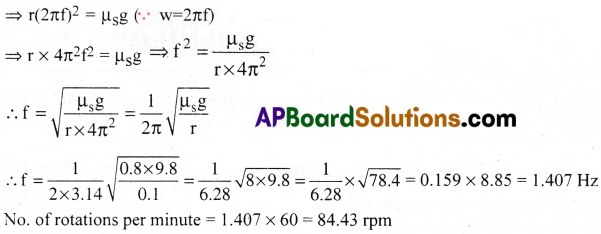
Question 4.
Particles of masses 1g, 2g, 3g, ……… 100g are kept at the marks 1cm, 2cm, 3cm ………. 100cm respectively on a meter scale. Find the moment of inertia of the system of particles about a perpendicular bisector of the meter scale.
Solution:

49gm particle is at a distance of 1 cm from axis of rotation.
So its moment of inertia is I1 = mr² = 49 (1)² gmcm²
51 gm particle is at a distance of 1cm from axis of rotation.
So its moment of inertia is I2 = 51 (1)² gmcm²
48 gm particle is at a distance of 2cm from axis of rotation.
So its moment of inertia is 4I3 = 48(2)² gmcm².
52 gm particle is at a distance of 2cm from axis of rotation.
So its moment of inertia is I4 = 52(2)² gmcm².
Similarly lgm particle is at a distance of 49cm from axis of rotation.
So its moment of inertia is (1) (49)2 gmcm2.
99 gm particle is at a distance of 49cm from axis of rotation.
So its moment of inertia is (99)(49)² gmcm²
100gm particle is at a distance of 50cm from axis of rotation.
So its moment of inertia is (100)(50)² gmcm²
Hence the total moment of inertia of the system about perpendicular bisector is
49(1)² + 51 (1)² + 48(2)² + 52(2)² + 47(3)² + 53(3)² + …… +(1)(49)² + 99(49)² + 100(50)².
⇒ (1)² [49 + 51] + 2²[48 + 52] + (3)²[47 + 53] + ….. + (49)²[1 + 99] + 100(50)²
⇒ (1)²[ 100] + 2²[100] + (3)²[ 100] + ….. + (49)²( 100) + (50)²( 100)
⇒ 100[1² + 2² + 3² + 4² +….+49² + 50²]

![]()
Question 5.
Three particles each of mass 100g are placed at the vertices of an equilateral triangle of side length 10cm. Find the moment of inertia of the system about an axis passing through the centroid of the triangle and perpendicular to its plane.
Solution:
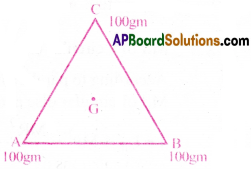
If the side of an equilateral triangle is a, then

Question 6.
Four particles each of mass 100g are placed at the corners of a square of side 10cm. Find the moment of inertia of the system about and axis passing through the centre of the square and perpendicular to its plane. Find also the radius of gyration of the system.
Solution:

Question 7.
Two uniform circular discs, each of mass 1kg and radius 20cm, are kept in contact about the tangent passing through the point of contact. Find the moment of inertia of the system about the tangent passing through the point of contact.
Solution:
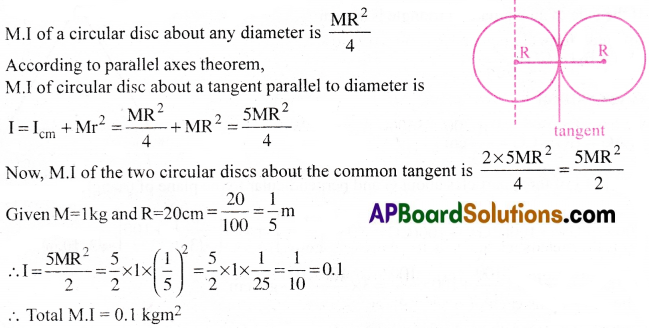
Question 8.
Four spheres each diameter 2a and mass ‘m’ are placed with their centres on the four corners of a square of the side b. Calculate the moment of inertia of the system about any side of the square. D
Solution:

Diameter of each sphere = 2a
∴ Radius of each sphere = a
Mass of each sphere = m
Consider the side AB as axis of rotation.
∴ For the spheres kept at A and B axis of rotation is their diameter.
We know that for a sphere, M.I. about a diameter is equal to \(\frac{2}{5}\) ma²
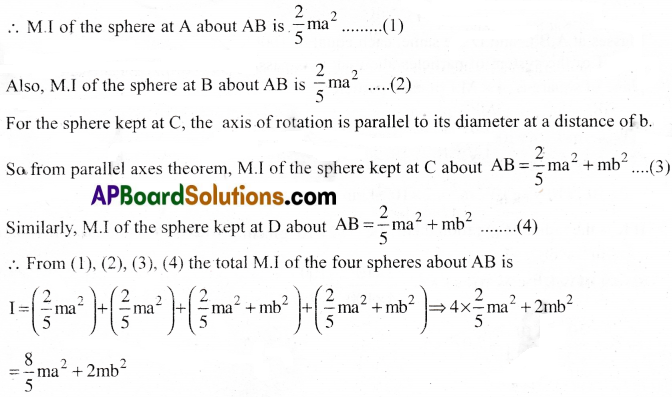
Question 9.
To maintain a rotor at a uniform angular speed or 200rad s-1, an engine needs to transmit a torque of 180Nm. What is the power required by the engine? (Note: uniform angular velocity in the absence of friction implies zero torque. In practice, applied torque is needed to counter frictional torque). Assume that the engine is 100% efficient.
Solution:
Given uniform angular speed (ω) = 200 rad s-1
Torque (τ) = 180 Nm
Power required by the engine, P = ?
We have P = τω = 180 × 200 = 36000 W = 36 kW
![]()
Question 10.
A meter stick is balanced on a knife edge at its centre. When two coins, each of mass 5g are put one on top of the other at the 12.0 cm mark, the stick is found to be balanced at 45.0 cm. What is the mass of the meter stick?
Solution:
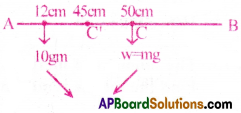
AB is the meter stick and C is its centre of gravity, from which its weight ‘w’ acts vertically downwards.
When two coins each of mass 5gm are placed at 12cm mark, the stick is balanced at C'(=45cm)
∴ Moment of w in clockwise = moment of 10gm in anticlockwise
Force × distance = Force × distance
⇒ w × (50 – 45) = 10 × g × (45 – 12)
⇒ (m × g)5 = 10 × g × 33 ⇒ m × 5 = 10 × 33 ⇒ m= 66 gm
Question 11.
Determine the kinetic energy of a circular disc rotating with a speed of 60rpm about an axis pafsing through a point on its circumference and perpendicular to its plane. The circular disc has a mass of 5kg and radius lm.
Solution:
M.I of a circular disc of mass M and radius R about an axis passing through its centre and perpendicular to its plane is Icm = \(\frac{MR^2}{2}\)
Now, from parallel axis theorem, M.I of the circular disc about a parallel axis at a distance R is
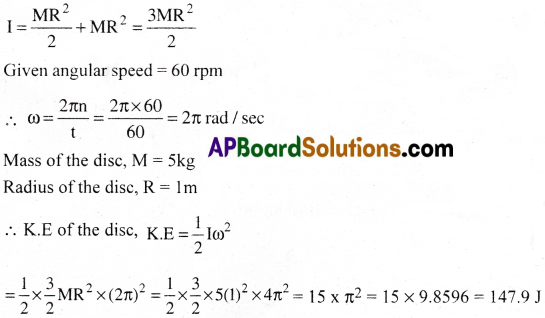
Question 12.
Two particles, each of mass m and speed u, travel in opposite directions along parallel lines separated by a distance d. Show that the vector angular momentum of the two particles system is the same whatever be the point about which the angular momentum is taken.
Solution:
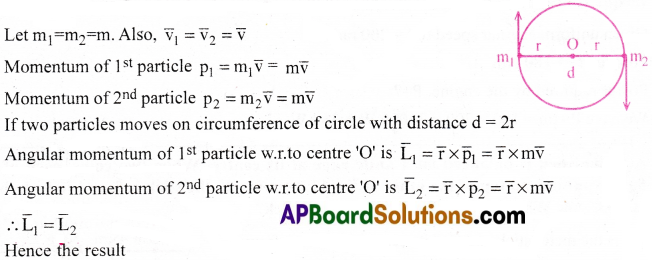
Question 13.
The moment of inertia of a fly wheel making 300 revolutions per minute is 0.3 kgm². Find the torque required to bring it to rest in 20s. [AP 20]
Solution:
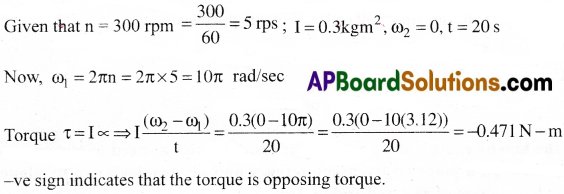
Question 14.
When 100J of work is done on a fly w heel, its angular velocity is increased from 60rpm to 180rpm. What is the moment of inertia of the wheel? [TS 16]
Solution:
Given W = 100J
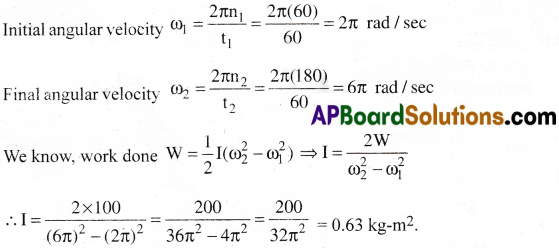
Multiple Choice Questions
Question 1.
The centre of mass of two particles with masses 4kg and 2kg located at (1,0,1), (2,2,0) respectively has the coordinates
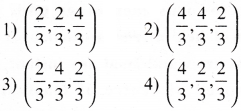
Answer:
4
Question 2.
The velocities of three particles of masses 20g, 30g and 50g are \(10\overrightarrow{i},10\overrightarrow{j}and10\overrightarrow{k}\) respectively. The velocity of the centre of mass of the three particles is

Answer:
1
![]()
Question 3.
If I is the moment of inertia of a body and ω is its angular velocity, then the rotational kinetic energy is

Answer:
4
Question 4.
The moment of inertia of a thin circular disc of mass M and radius R about any diameter is
1) MR²
2) MR²/4
3) MR²/2
4) 2MR²
Answer:
2
Question 5.
Moment of inertia of a solid sphere along the direction of tangent is

Answer:
4
Question 6.
A fan is making 600 rpm. If it makes 1200 rpm, the increase in its angular velocity is
1) 10π rad s-1
2) 20π rad s-1
3) 60π rad s-1
4) 40π rad s-1
Answer:
2) 20π rad s-1
Question 7.
One solid sphere A and another hallow sphere B are of same mass and same outer radii. Their moment of inertia about their diameters are respectively I v and IR such that
1) IA = IB
2) IA > IB
3) IA < IB
4) \(\frac{I_A}{I_B}=\frac{d_A}{d_B}\)
Answer:
3) IA < IB
Question 8.
Find the torque of a force \(\overrightarrow{F}=-3\hat{i}+\hat{j}+5\hat{k}\) acting at the point \(\overrightarrow{r}=7\hat{i}+3\hat{j}+\hat{k}\)

Answer:
3
Question 9.
What is the torque of the force \(\overrightarrow{F}=2\hat{i}-3\hat{j}+4\hat{k}\) N acting at the point \(\overrightarrow{r}=3\hat{i}+2\hat{j}+3\hat{k}\) m about origin?

Answer:
4
Question 10.
The moment of the force, \(\overrightarrow{F}=4\hat{i}+5\hat{j}-6\hat{k}\) at (2, 0, -3), about the point (2, -2, -2), is given by

Answer:
4
Question 11.
Find the torque about the origin when a force of 3\(\hat{j}\)N acts on a particle whose position vector is 2km
1) 6\(\hat{i}\) Nm
2) 6\(\hat{j}\) Nm
3) -6\(\hat{i}\) Nm
4) 6\(\hat{k}\) Nm
Answer:
3) -6\(\hat{i}\) Nm
![]()
Question 12.
What is the value of linear velocity, if
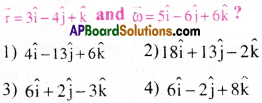
Answer:
2
Question 13.
\(\vec{A}and\vec{B}\) are two vectors and θ is the angie between them, if \(|\vec{A} \times \vec{B}|=\sqrt{3}(\vec{A}, \vec{B})\), the value of θ is
1) 45°
2) 30°
3) 90°
4) 60°
Answer:
4
Question 14.
If \(|\vec{A} \times \vec{B}|=\sqrt{3}\vec{A}, \vec{B}\) then the value of . \(|\vec{A} + \vec{B}|\)

Answer:
1
Question 15.
The resultant of \(\vec{A} \times \vec{0}\) will be equal to
1) zero
2) A
3) zero vector
4) unit vector.
Answer:
3
Question 16.
Two particles of mass 5 kg and 10 kg respectively are attached to the two ends of a rigid rod of length 1 m with negligible mass. The centre of mass of the system from the 5 kg particle is nearly at a distance of
1) 33 cm
2) 50 cm
3) 67 cm
4) 80 cm
Answer:
3) 67 cm
Question 17.
Three masses are placed on the x-axis : 300 g at origin, 500 g at x = 40 cm and 400 g at x = 70 cm. The distance of the centre of mass from the origin is
1) 40 cm
2) 45 cm
3) 50 cm
4) 30 cm
Answer:
1) 40 cm
Question 18.
Two particles which are initially at rest, move towards each other under the action of their internal attraction. If their speeds are v and 2v at any instant, then the speed of centre of mass of the system w ill be
1) 2v
2) zero
3) 1.5v
4) v
Answer:
2) zero
Question 19.
Two bodies of mass 1 kg and 3 kg have position vectors \(\hat{i}+2\hat{j}+\hat{k}and-3\hat{i}-2\hat{j}+\hat{k}\) respectively. The centre of mass of this system has a position vector

Answer:
1
Question 20.
The ceptre of mass of system of particles does not depend on
1) position of the particles
2) relative distances between the particles
3) masses of the particles
4) forces acting on the particle.
Answer:
4) forces acting on the particle.
![]()
Question 21.
The moment of inertia of a disc of mass M and radius R about an axis, which is tangential to the circumference of the disc and parallel to its diameter is

Answer:
1
Question 22.
The moment of inertia of a uniform circular disc is maximum about an axis perpendicular to the disc and passing through

1) B
2) C
3) D
4) A
Answer:
1) B
Question 23.
A disc of radius 2 m and mass 100 kg rolls on a horizontal floor. Its centre of mass has speed of 20 cm/s. How much work is needed to stop it?
1) 1 J
2) 3 J
3) 30 kJ
4) 2 J
Answer:
2) 3 J
Question 24.
From a circular disc of radius R and mass 9M, a small disc of mass M and radius R/3 is removed concentrically. The moment of inertia of the remaining disc about an axis perpendicular to the plane of the disc and passing through its centre is
1) \(\frac{40}{9}\)MR²
2) MR²
3) 4MR²
4) \(\frac{4}{9}\)MR²
Answer:
1) \(\frac{40}{9}\)MR²
Question 25.
A disc is rotating with angular speed to. If a child sits on it, what is conserved?
1) linear momentum.
2) angular momentum.
3) kinetic energy.
4) potential energy
Answer:
2) angular momentum.
Question 26.
The ratio of the radii of gyration of a circular disc to that of a circular ring, each of same mass and radius, around their respective axes is
1) √2 : 1
2) √2 : √3
3) √3 : √2
4) 1 : √2
Answer:
4) 1 : √2
Question 27.
A ring of mass m and radius r rotates about an axis passing through its centre 1 and perpendicular to its plane with i angular velocity co. its kinetic energy is
1) \(\frac{1}{2}\) mr²ω²
2) mrω²
3) mr²ω²
4) \(\frac{1}{2}\) mrω²
Answer:
1) \(\frac{1}{2}\) mr²ω²
Question 28.
A wheel has angular acceleration of 3.0 rad/sec2 and an initial angular speed of 2.00 rad/sec. In a time of 2 sec it has rotated through an angle (in radians) of
1) 10
2) 12
3) 4
4) 6
Answer:
1) 10
Question 29.
Two bodies have their moments of inertia I and 2I respectively about their axis of rotation. If their kinetic energies of rotation are equal, their angular velocity will be in the ratio
1) 2 : 1
2) 1 : 2
3) √2 : 1
4) 1 : √2
Answer:
3) √2 : 1
Question 30.
A fly wheel rotating about fixed axis has a kinetic energy of 360 joule when its angular speed is 30 radian/sec. The moment of inertia of the wheel about the axis of rotation is
1) 0.6 kg m²
2) 0.15 kg m²
3) 0.8 kg m²
4) 0.75 kg m²
Answer:
3) 0.8 kg m²
Question 31.
A rope is wound around a hollow cylinder of mass 3 kg and radius 40 cm. What is the angular acceleration of the cylinder if the rope is pulled with a force of 30 N?
1) 0.25 rad s-2
2) 25 rad s-2
3) 5 m s-2
4) 25 m s-2
Answer:
2) 25 rad s-2
![]()
Question 32.
A couple produces
1) linear and rotational motion
2) no motion
3) purely linear motion
4) purely rotational motion
Answer:
4) purely rotational motion